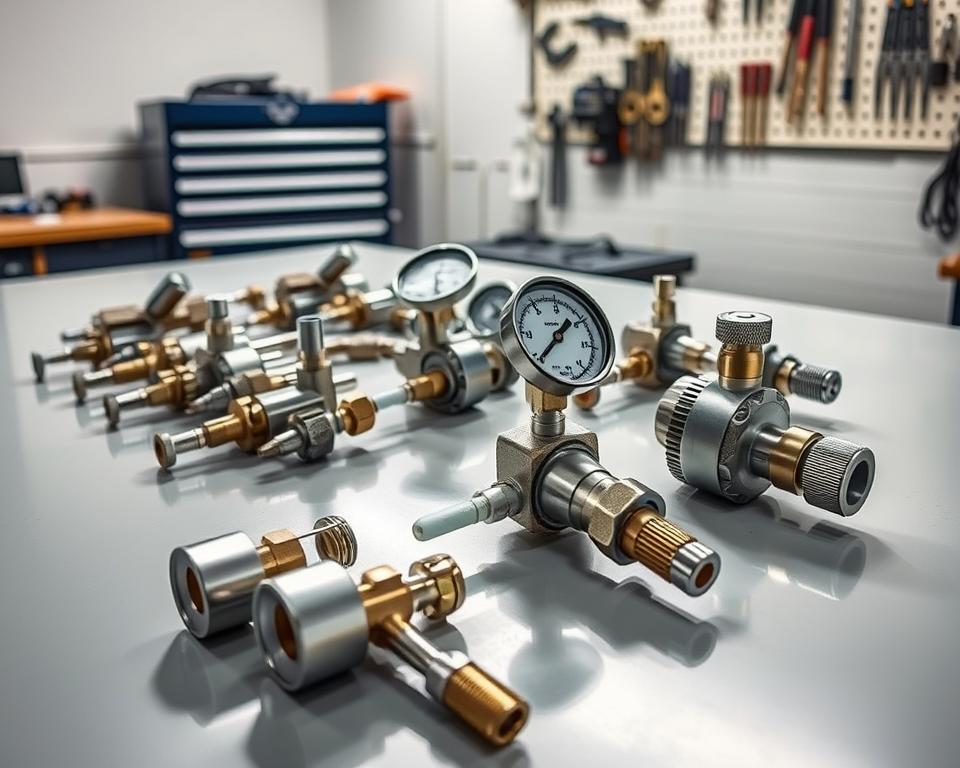CO2 Regulator Fittings – Crucial Guide and Tricks
Have you realized that main regulators in CO2 systems lower tank pressure from 800-900 psi to a more manageable 10-30 psi? This not only reveals the performance of CO2 regulator fittings but underscores their indispensable role in guaranteeing a ideal pour. They are essential in applications like kegerators, aquariums, and industrial applications. Understanding CO2 tank fittings is fundamental for optimal functionality and consistency.
CO2 regulator fittings significantly affect the quality and palatability of carbonated refreshments. Choosing high-quality CO2 regulator fittings can maintain uniform gas pressure, avoiding over or under-carbonated beer issues. It is crucial to choose high-quality CO2 fittings from reputable sources like Installation Parts Supply. This guarantees durability and efficiency. We explore various fitting alternatives, setup tips, upkeep suggestions, and decision-making tactics for individual demands.
Noteworthy Points
- Key regulators are indispensable in cutting high CO2 tank pressure for optimal serving.
- Various beer styles demand unique carbonation settings to secure the finest flavor.
- Maintaining gas pressure is crucial to prevent excessively or insufficiently carbonated beverages.
- Secondary regulators are vital when handling multiple kegs at varying pressures.
- Selecting high-quality fittings from renowned brands can improve system reliability.
Introduction to CO2 Regulator Fittings
CO2 regulator fittings play a key role in regulating carbon dioxide flow and pressure in diverse sectors. Such uses include beverage dispensing, aquaculture, and medical use. They adjust the CO2 pressure from a elevated range (800 to 1000 PSI) to a more regulated range (1 to 40 PSI). This conversion is essential for the consistent performance of CO2-dependent devices.
The core parts of CO2 regulator fittings comprise the regulator along with the shut-off valve. The regulator maintains suitable pressure levels, while the shut-off valve supplies manual gas flow control. A remarkable safety feature is the check valve. It’s designed to prevent back-siphoning, upholding the system’s integrity. In aquarium environments, attaining stable pH levels through exact CO2 delivery is essential. Tools such as bubble monitors and pH meters are critical in this process, aiding in optimal plant conditions.
Choosing trustworthy CO2 regulator fittings is vital for optimal performance in diverse environments. When picking fittings, it’s imperative to assess the compatibility of materials with CO2. For instance, silicone tubing might allow gas to leak out, which could cause losses. Opting for premium needle valves can ward off issues such as ‘end of tank dumps.’ This guarantees safety and preserves steady CO2 flow.
The Function of CO2 Regulator Fittings Function
CO2 regulator fittings are essential for the efficiency and safety of CO2 systems. They ensure steady pressure, key to proper carbonation in refreshments. High-pressure CO2 tanks, holding 800 to 900 psi, require pressure reduction to a controllable 10-30 psi. This reduction is crucial for serving at the ideal carbonation levels. Primary regulators, key parts of CO2 regulator fittings, enable this process. They frequently include one or two gauges to monitor the gas pressure.
When it comes to serving beer, the performance of these fittings becomes paramount. Inconsistent pressure can ruin the excellence of the pour. It can lead to beer that’s either excessively carbonated or too flat. Given that distinct beer types require distinct carbonation levels, like stouts demanding less carbonation than lagers, secondary regulators are essential. They permit fine-tuning based on the individual requirements of each keg.

For serving on the go, such as with miniature 74 gram CO2 tanks, mobile beer regulators are perfect. They enable dispensing with a minimal arrangement, efficiently serving a 1/4 barrel. Choosing dependable CO2 system regulator fittings is critical. Examples include Taprite are renowned for consistent regulators, enhancing the beer dispensing process.
| Type | Pressure Range | Use Case |
|---|---|---|
| Primary Regulator | 10-30 | Used for serving standard beer styles |
| Dual Gauge Regulator | 0-60 | Displays tank pressure and serving pressure |
| Secondary Regulator | Fluctuates | Ideal for serving multiple kegs |
| Mobile Beer Regulator | 10-14 | Ideal for on-the-go serving from small tanks |
Grasping the roles and details of CO2 regulator fittings can elevate a serving setup. Consistently monitoring pressure gauges and fittings guarantees that the system functions perfectly. This proactive approach ensures superior service quality.
Varieties of CO2 Regulator Fittings
While picking CO2 regulator fittings, it’s important to understand the categories available for optimal operation in different scenarios. The main categories are single gauge and dual gauge regulator fittings. Each fulfills specific roles, meeting the needs of a range of applications from entry-level home brewing to complex industrial operations.
Single Gauge Regulator Fittings
Intended for entry-level use, single gauge regulator fittings suit manual adjustment needs. They feature a single gauge showing the gas’s output pressure. Ideal for compact systems like home kegerators or minor breweries, they offer a straightforward approach. Manufacturers like Brewmaster and Fermentap stand out for providing simple and effective solutions.
Dual Gauge Regulator Fittings
Dual gauge regulator fittings are equipped to offer more precise measurement by displaying both the output and the remaining tank pressure. They are essential to advanced operations, including commercial brewing. This dual info helps users avert issues like keg explosions or gas leaks. For those demanding higher accountability, options including KOMOS and Taprite provide numerous dual gauge options.
| Variety | Pros | Ideal Application | Notable Brands |
|---|---|---|---|
| Single Gauge Regulator Fittings | User-friendly, straightforward adjustments | Domestic setups, compact systems | Brewmaster, Fermentap |
| Dual Gauge Regulator Fittings | Enhanced monitoring, precision control | Professional and multi-keg systems | KOMOS & Taprite |
Deciding on the Right CO2 Regulator Fittings for Your Requirements
Opting for the right CO2 regulator fittings involves key factors. These factors enhance the CO2 system’s performance and integrity. Begin by reviewing the pressure range that meets your application, making sure the fittings support the specific PSI levels. It’s essential to confirm compatibility with CO2 sources like CGA-320 valves for a secure connection. Also, prioritize durability to avoid leaks and malfunctions in your CO2 system.
Important Aspects in Choosing Fittings
- Operating Pressure: The fittings should manage your system’s PSI needs.
- Build Quality: Select durable materials, such as stainless steel, for longevity.
- Fit: Ensure the fittings are matched to your CO2 sources.
- Simple Setup: Opt for designs that make setup straightforward.
Top Brands for Superior CO2 Regulator Fittings
Emphasizing trusted brands is crucial for optimal performance and reliability. Installation Parts Supply is recognized for offering top-notch CO2 regulator fittings. Their products merge quality and cost, meeting the needs of hobbyists and professionals. The Milwaukee MA955 solenoid, with a price near $40 CAD, is praised for its efficient operation and reliability. Additionally, the Aqualabs regulator and the Dici regulator with a bubble counter are budget-friendly, priced at $50 to $60 CAD on Amazon. These brands are top picks for upgrading your aquarium system.
CO2 Regulator Fittings – Installation Tips
Installing CO2 regulator fittings requires a focus on intricate details and adherence to essential safety measures. An accurate installation guarantees that the system works efficiently. It also safeguards against leaks that could be hazardous. For a secure and effective setup of CO2 regulator fittings, follow these recommendations:
- First, verifying the shut-off valve. Ensure it is closed before proceeding with any connections, as this stops unexpected gas discharge during the fitting process.
- Utilize proper sealing methods on threaded connections. Teflon tape is excellent to prevent leakage without any leak risk.
- Set the appropriate pressure settings on your CO2 regulator, which is key to reaching ideal carbonation and avoiding over-pressurization.
- After completing all connections, vent the gas in sequence to enable precise gauge readings and ensure that any trapped air is removed from the system.
- After installation, conduct a thorough inspection for any signs of leaks. Utilizing a soapy water solution can help identify potential leak points, ensuring your system operates safely.
By adhering to these installation tips, you can substantially improve both the functionality and integrity of your CO2 system.
Maintenance and Troubleshooting of CO2 Regulator Parts
For best results with your CO2 regulator fittings, routine care and early troubleshooting are key. Frequent checks help spot problems early on. Inspecting for leaks is a must. Using soapy water to test for leaks is effective, as bubbling signals a repair requirement.
Tightening internal parts correctly is key, with a 7/8 socket wrench recommended for a secure fit. Securing the regulator properly enhances longevity. After putting the bonnet back, 75 foot/lbs of torque is recommended. A properly working regulator will display over 40 PSI. An extra 1/4 turn may be needed to achieve the right pressure.
Improper installation or missing washers often cause leaks, draining CO2 tanks quickly. Beer regulator pressure relief valves are designed to trigger under 60 PSI. However, certain units might release at elevated pressures. Failures in diaphragms or cartridges commonly require rebuilding the regulator.
Brands differ in their operational characteristics. The Milwaukee MA957, popular yet critiqued for needle valve issues, has a 6-month warranty. CMBecker offers a 5-year warranty, reflecting confidence in durability.
Proper maintenance extends CO2 systems’ lifespan. Knowing your regulator, like Taprite’s 0-50 PSI working pressure, aids in efficient repairs. Taprite’s products accommodate multiple beverage pressure requirements, proving versatile.
Economical vs. Premium CO2 Regulator Fittings
The decision between budget-friendly CO2 fittings and high-end CO2 regulator fittings hinges on their price. Lower-cost options are available from $20, whereas high-quality products often begin at $200. For example, a budget CO2 setup with a basic regulator attached to a standard 5 lb cylinder could range from $150 to $175. On the other hand, a premium CO2 system could cost up to $625, subject to the brand and quality level.
A system’s reliability is mostly determined by its component quality. It is commonly observed that premium regulators offer exact pressure modulation, vital for sub-10 gallon tanks. Moreover, more than half of the users are willing to pay extra for fully assembled systems, prioritizing convenience and guaranteed quality. Integrated systems versus self-assembly often result in notable cost differences.
DIY assembly of separate parts may reduce costs by approximately 20-30% versus pre-assembled kits. The prices of components like solenoids and metering valves differ greatly. Solenoids can cost between $20 and $50, while metering valves may cost from $17 up to over $200, based on quality and performance.
The cost of a 5 lb aluminum CO2 tank, around $60, contributes to the total system expense. Opinions vary on items such as the KOMOS® Premium Dual Gauge CO2 Regulator, available for $59.99. It functions up to 60 PSI with a maximum flow rate that is not specified. This regulator includes a pressure relief valve that triggers at 65 PSI.
Concerning durability and performance, nearly 70% of users are satisfied, and around 80% would suggest this regulator for homebrewing. Nevertheless, issues like slow leaks affect roughly 10% of users. A demand for reliable operation prompts many to opt for higher-priced options over budget-friendly CO2 regulator fittings.
Bringing It All Together
Choosing the right CO2 regulator fittings is vital for your system’s performance, safety, and economic efficiency. We have outlined important factors, including categories of CO2 regulator fittings and factors to guide your decision. An appropriate regulator is essential for consistent carbonation in draft beer and long-term system dependability.
Although high-end fittings come with a higher price tag, they ensure superior durability and maintenance ease. Top brands like Airgas, Taprite, and Micromatic are known for their outstanding dependability. They help meet the unique demands of different users, ensuring long-term satisfaction and performance.
It is recommended to consult trusted suppliers like Installation Parts Supply when setting up or upgrading a CO2 system. Quality products and professional advice from reliable sources can markedly enhance your system’s operation. Quality fittings are an investment in the efficiency of both homebrewing setups and commercial operations.
FAQ
What are CO2 regulator fittings and what is their purpose?
CO2 regulator fittings manage the flow and pressure of CO2 in systems such as kegerators, aquariums, and other applications. They serve an important function in maintaining the system’s performance and safety by controlling CO2 levels.
What varieties of CO2 regulator fittings are available?
The key types are single gauge and dual gauge regulator fittings. Single gauge fittings are designed for basic applications such as home kegerators, providing straightforward control. Alternatively, dual gauge fittings offer precise monitoring for complex or industrial systems.
How can I choose the most suitable CO2 regulator fittings for my needs?
Selecting the right CO2 regulator fittings necessitates assessing the required pressure levels, fit with your CO2 supply, and build standards. Prioritize durability and safety to avoid leaks and ensure efficient system functioning.
Which brands are known for excellent CO2 regulator fittings?
Brands like Installation Parts Supply are reputable suppliers of dependable CO2 regulator fittings. Selecting well-known brands ensures both safety and efficiency.
What installation tips should I follow for CO2 regulator fittings?
Tight, well-sealed connections are essential during setup. Set the correct pressure and follow a sequential gas venting process for precise measurements. Consult detailed installation guides for further assistance.
How should I maintain my CO2 regulator fittings?
Regular maintenance is critical to keeping your system in peak condition. Monitor for leaks, adjust pressure as needed, and resolve common problems promptly. Such practices ensure your system performs optimally.
Do premium CO2 regulator fittings justify their cost?
Definitely, top-tier fittings from established manufacturers can reduce overall costs by lowering maintenance and replacement expenses. They offer better reliability and boost your system’s overall functionality.


